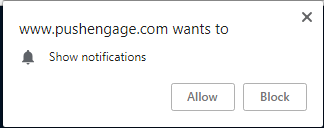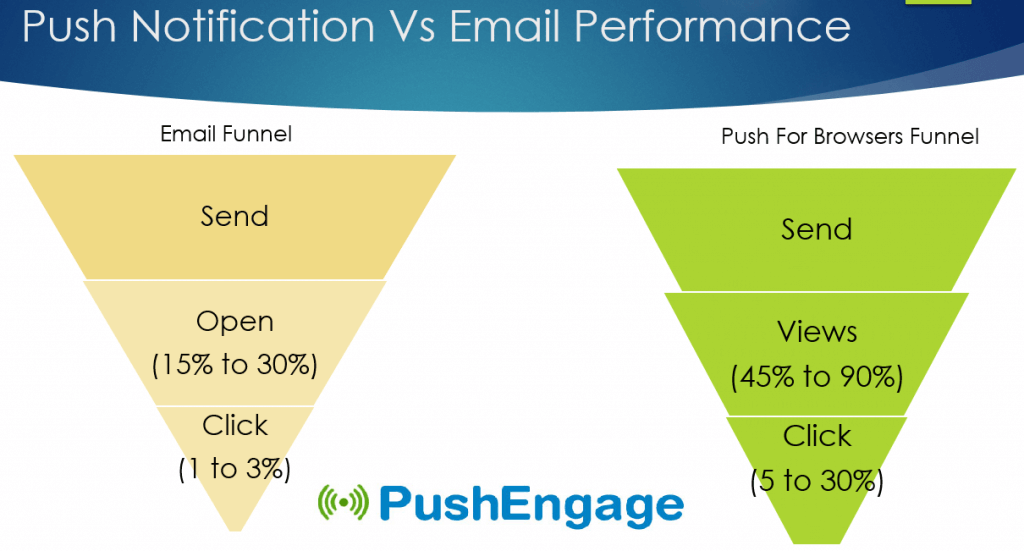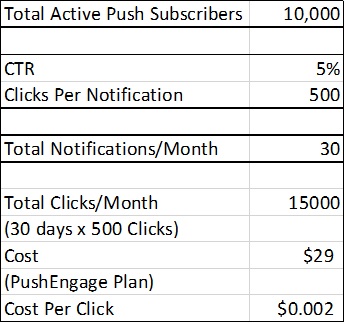If you run a content site, you might be looking to increase the traffic to your website. Current algorithm changes with Facebook have impacted the organic traffic from social channels, and the ad blockers have impacted the ad revenue for content sites.
Web Push Notifications, which is a newly launched channel can increase traffic by 30 to 40% to your content websites. Your customers are looking for fresh content on your site, and want to be alerted when you publish them, and not have to check your site daily if there is fresh content or not. Notifications are a suitable mechanism to accomplish that.
What is Browser Push Notification?
Mobile Apps have used notifications to increase user engagement and now the same technology is available in browsers as well. You send an alert to a user sharing important updates with your readers and this brings back the user to your website. You can easily boost website traffic using push notifications.
The website comes to the user for the important things and makes the experience superior for your customer. Another key point is that the notification is sent to the user when he is online in his browser and he may not be present on your website.
With Chrome announcing its support for Push Notifications in April 2015, and Firefox in Jan 2016, this became available in Chrome, Firefox, and Safari, which represents 70% + market share of browsers. You can check your own analytics data but the majority of your users are available to be re-engaged through this channel.

Why Browser Push Notifications?
You get several visitors to your site, and you want to increase your repeat users to benefit the most from a new user acquisition. Engagement is a key focus metric for several sites, and it increases the lifetime value of your customer, thus allowing you more room in your paid acquisition.
In terms of available re-engagement tactics, usually, you would consider:
- Email lists – Gather email subscribers on your website and later send them emails to engage with them.
- Re-targeting – Pixel the user when he visits your site and retargets him on various search and social platforms.
Now you have a 3rd option of Browser Push Notification which has a higher efficiency over Email, and much cheaper than re-targeting.
We gathered data for several push notifications send through our platform PushEngage, and saw that the Click Rates for Browser Push Notifications varied between 5 to 30%, and was 2x to 10x higher than Email. We calculate Click Rate as # Click/Subscribers Notification or Email is sent.

We compared the cost of a Browser Push Notification channel against Retargeting and found that the cost per click was only $0.002, which was at least 10x lower than any possible retargeting for any sector out there. The below calculation assumed that the site uses the $29 plan with 10,000 Push Notification subscribers:

3 more reasons why content sites need browser-based Push Notifications
If we haven’t convinced you enough here are 3 more reasons why you should consider using Browser Push Notification with PushEngage on your site:
Send notifications in mobile, without owning a mobile app
It is evident that the world is witnessing a mobile era. For companies to survive they should have a strong mobile strategy. This leads to many marketers as well as bloggers to build mobile-oriented campaigns and tools to support it.
The increase in the number of mobile addicts gives rise to mobile websites and mobile apps. Personalization via mobile apps generates more revenue according to business. Now some of those benefits are available to you even without spending resources on your mobile app.
You can use a platform for Browser Push Notifications like Pushengage that helps you to send mobile notifications to your subscribers without owning a mobile app. Also, you can send mobile notifications to your users to convert subscribers in a single click option displayed on your website.
The Easier, Faster way to build your Marketing List
A growing marketing list is the primary strategy of any online marketing. Certainly, bloggers are adding contacts regularly to keep the list fresh. By offering freebies like ebooks and inviting audiences for an unavoidable webinar, bloggers find their unique growth approach.
Browser Push Notification platform like PushEngage is a handy tool for every blogger to grow the marketing list very quickly and easily. PushEngage offers a single tap subscribe option to HTTP sites and HTTPS sites equally and simplifies the customer experience. The fewer steps you have in the process, the less friction you will have, which increases the subscriber conversion rate. In terms of opt-in rates, since this is a one-click opt-in, we see much higher opt-in rates. As compared to your email opt-in rate you could see up to 50 to 100% higher opt-in rate than email subscription rate.
With PushEngage, users can subscribe in one click and need not to share any personal information. They will receive the notifications from their favorite websites on their browsers.
Automated Push Notifications for Content Sites, means little extra work for increased traffic
Blogging is one of the most recommended methods for a business/individual to engage with customers. The continuous practice of blogging helps you to get clear on the ideal audience you want to reach and the community you want to build.
From small websites to fortune 500, companies are building a strong online presence with refreshing content. It is one of the cost-effective strategies which will reap benefits for a long time.
However, successful blogging not only requires amazing content but also reaching the readers in a more sophisticated way. To increase reach, you need a high subscription rate. You can easily increase subscribers on the blog using web push notifications.
PushEngage offers a WordPress Plugin, that automatically sends out a notification when a new post is published. For non-WordPress blogs, we offer an RSS based automation where we send out a push notification automatically based on new posts published to your RSS feed. This is a great value add for bloggers as now they don’t need to spend time manually sending push notifications.
How to Implement Browser Push Notifications on your Website?
Implementing Browser Push Notifications on your site is relatively straightforward with a platform like PushEngage. You would need to add the javascript code to your website to go live. Later you can use the dashboard to configure what kind of opt-in popup you want to show your users. Remember, if you have an opt-in process that has the least number of steps while explaining the purpose of your opt-in you will have a higher rate of subscription.
Remember push notifications require an HTTPS site for subscription, so if you don’t already have one, you can use the subdomain provided by us which is an HTTPS subdomain for you, for subscription and sending messages.
Engage Your Users With Push Notifications
Once you have implemented Web Push Notifications on your website, you would need to think about the campaigns you want to run, to engage your users. The most common ideas are around Breaking News Alerts, or if you publish a key article. Using the right tactics, you can increase the push notification click through rate of the blog. Depending on the type of content site, you could be pushing live cricket scores, or sharing daily test preparation material to your users, or sharing about the relevant conference in your industry. You can also drive increased likes on Facebook or get more Twitter followers, or get app downloads by cross-promoting to these users.
Remember to engage with your users on a regular basis, and at the same time avoid being spammy by sending only relevant and personalized notifications. This is possible by segmenting your users and sending notifications based on their preferences and site actions. It is important to keep your unsubscribe rate lower. The subscription/unsubscription is managed in your browser settings and it is hard to get an unsubscribed user to subscribe again.
Another key point to keep in mind is that when you start building the Browser Push subscriber list, it will take some time to build your list. There isn’t a way currently to import your registered users and convert them into a push subscriber, as the opt-in process is explicit per user. But the effort to build the list is worth it, given the ROI.
Summary
Browser Push Notification is a must-have additional channel for content sites, and it helps increase traffic/revenue to your site and improves your repeat visits. You can follow the web push notification guide for content website and implement on your website. This is a channel with higher ROI over email and re-targeting. So you must add it to your marketing plan. It requires some effort to understand and use this channel but this is worth your time and effort.
If you still have not registered, click here to register for a Free plan at PushEngage
ps: This post originally appeared here, and we are reproducing for the benefit of our blog readers.

The benefit of pixel based re-targeting over email is the volume of the audience you can reach. It is understandable that push-notification subscribers would perform better than their email counterparts as it is front-and-center on the receiving device but the important question here is: What is the size of your push-notification audience vs the email-subscriber audience?
Great point George. Since we see higher opt-in rates for Push subscribers, over some time period you would like have more push-notification subscribers vs. email. In terms of impact (i.e. say clicks to your site), this can happen much earlier due to better performance of Push Notifications.
hai iam anuradha student from india,unfortunately i visited ur website .it’s cool info and good articles u sended to us , i really like ur article because i got good info, when i read ur articles. thankds for shareing like this article . i will tell to all my friends about ur website , keep share and post best regard
how to install in Joomla?
Hi ,
This is a wonderful and a highly insightful blog post.
the content on this website is very nice and helpfull for us